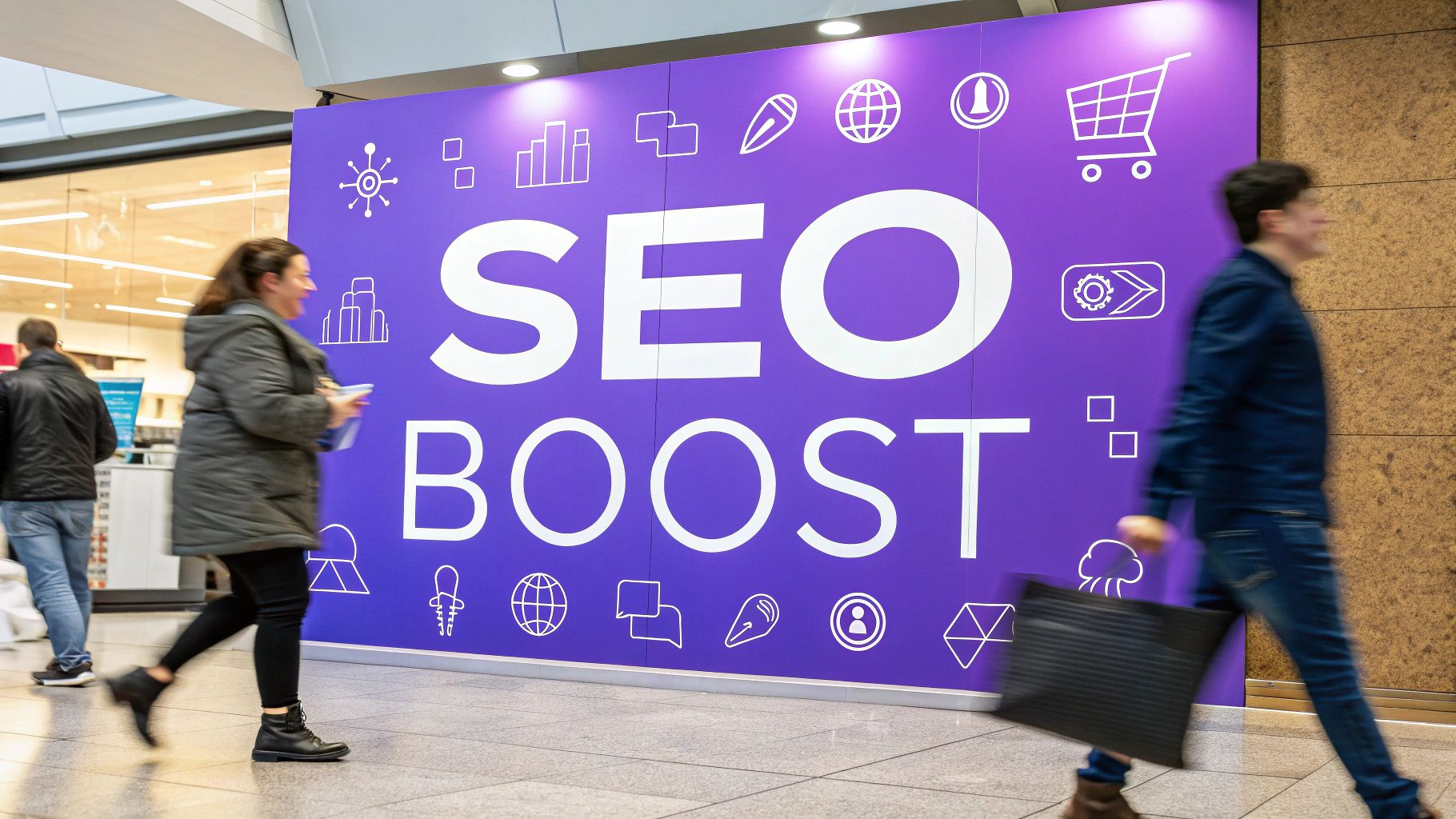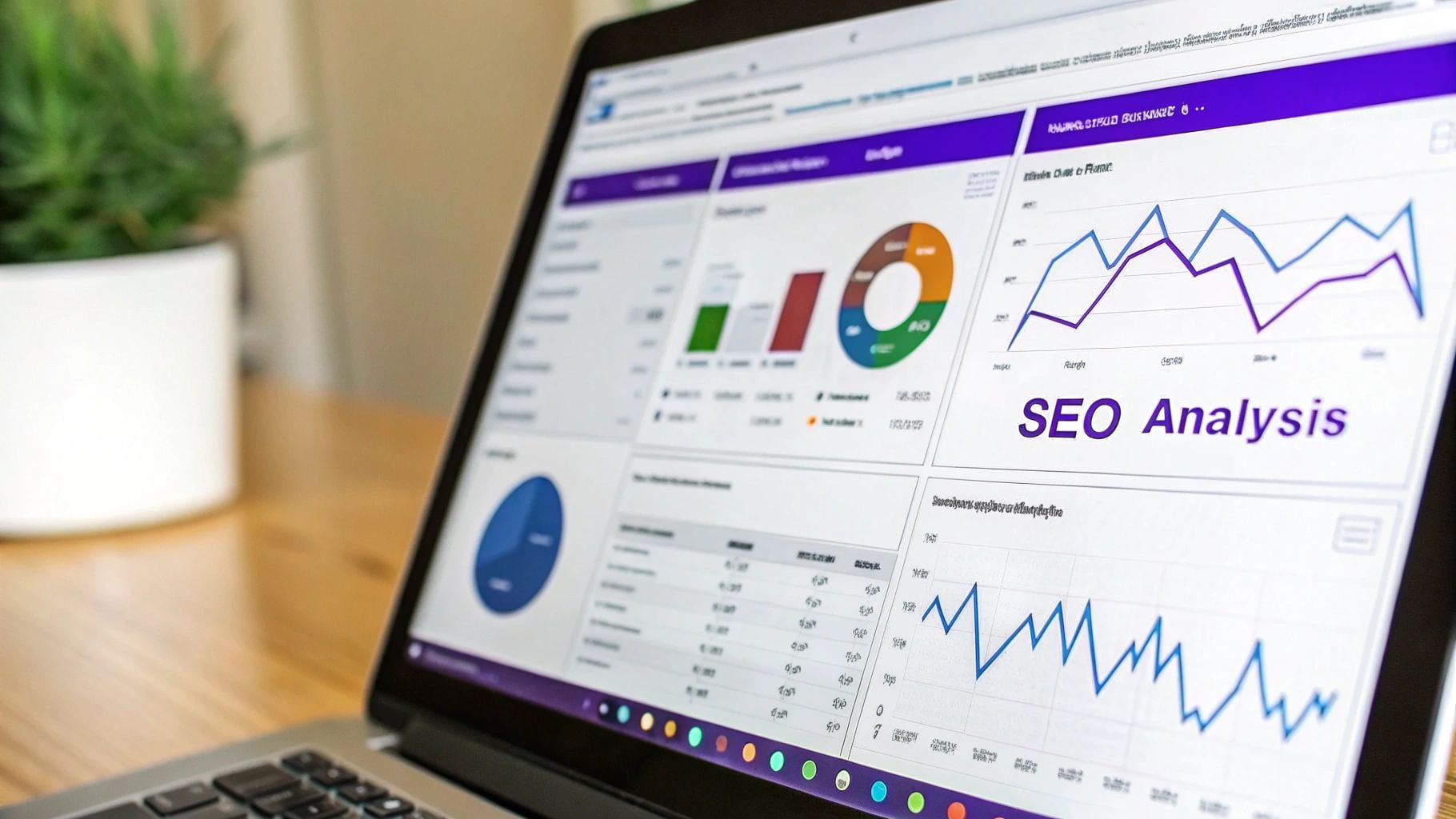The Ultimate Guide to SEO Optimization for Ecommerce: Transform Your Online Store's Growth

Understanding the True Power of Organic Search

While paid advertising can provide quick visibility, focusing solely on paid channels means missing out on the immense potential of organic search. The reality is that organic traffic, built through effective SEO practices, creates lasting value that paid campaigns simply can't match. By investing in organic search strategies, you establish a foundation for steady, sustainable growth rather than relying on temporary bursts of paid traffic.
Why Organic Search Matters for E-commerce
The numbers tell a compelling story about organic search's importance in e-commerce success. Consider this: 33% of all e-commerce website visits come from organic search results. This means one-third of potential customers are finding products through natural search queries. For example, when someone searches for "handmade ceramic mugs," appearing prominently in organic results connects you with a highly interested buyer - without paying for an ad click. Even better, about 24% of e-commerce orders can be traced back to organic traffic sources.
The financial case for organic search is equally strong. Studies show that organic search delivers an impressive 1,600% return on investment compared to paid search campaigns. This exceptional ROI stems from organic search's ability to build lasting brand authority and connect with customers actively seeking solutions.
Aligning with Customer Search Behavior
Success in organic search starts with understanding how customers actually search. Most online searches begin with a specific need or problem to solve. By creating content that directly addresses these real customer needs, you can attract more qualified visitors to your site.
Take someone searching for "best running shoes for flat feet" - this shows clear buying intent. You can capture this traffic by publishing helpful content like detailed shoe reviews or buyer's guides that specifically address flat feet concerns. This naturally draws in prospective customers and guides them toward relevant products.
Building a Sustainable Organic Growth Framework
Creating lasting organic growth requires focusing on three key areas:
- Comprehensive Keyword Research: Find out exactly what terms your target customers use when searching. This helps optimize your pages to appear for relevant queries.
- High-Quality Content Creation: Develop genuinely helpful content like detailed buying guides, product comparisons, and how-to articles that answer customer questions.
- Technical SEO Optimization: Ensure your site loads quickly, works well on mobile devices, and has a clean structure that search engines can easily understand.
By consistently executing these strategies, you'll build strong organic visibility that brings qualified traffic and drives ongoing sales growth. This patient, strategic approach helps establish your brand as an authority while delivering much better long-term results compared to paid advertising alone.
Mastering Mobile-First SEO for Modern Shoppers

The way people shop online has fundamentally shifted toward mobile devices. Over 55% of web browsing now happens on phones and tablets rather than desktop computers. This major change means search engines like Google now look primarily at mobile versions of websites when deciding search rankings. For online stores, getting mobile SEO right has become essential for reaching customers.
Optimizing for the Mobile Customer Journey
Mobile shoppers have distinct habits and needs compared to desktop users. They often search while on the move, use voice commands, type shorter queries, and look for local results. A perfect example is someone searching "coffee shops near me" while walking around town. This means your SEO strategy needs to adapt to these mobile behaviors to succeed.
The shift toward mobile has big implications for keyword research and content. You'll want to target terms used in local searches, optimize for voice queries, and make sure your content reads well on small screens. Local "near me" searches have grown tremendously - up 200% between 2016 and 2019. This shows how important it is to focus on location-based SEO if you want to reach mobile shoppers.
Avoiding Mobile Optimization Pitfalls
Many online stores make common mistakes with mobile optimization. Slow loading times are a major issue - even a one-second delay can cause shoppers to leave. Poor user experience like tiny buttons, messy layouts and hard-to-navigate menus also drive customers away quickly.
Practical Approaches to Mobile SEO
Here are key ways to improve your mobile SEO:
- Page Speed Optimization: Make your mobile site load fast by compressing images, reducing HTTP requests, and using browser caching. Use Google's PageSpeed Insights to find areas to improve.
- Mobile-Friendly Design: Build a responsive site that works smoothly across all screen sizes with easy navigation and clear calls to action.
- Structured Data Implementation: Add schema markup to help search engines understand your product pages better and show rich results.
- Local SEO Optimization: If you have physical stores, optimize your Google Business Profile and target location-specific keywords.
- Content Optimization for Mobile: Format content for small screens using short paragraphs, bullet points, and clear headings.
Following these guidelines helps create a mobile experience that both satisfies search engines and keeps customers happy. Since mobile continues to grow, regularly testing and improving your mobile SEO is key to long-term success.
Building a Winning Product Page Strategy
Your product pages are where the magic happens - they're the critical point where browsers make the decision to become buyers. Let's explore how to optimize these pages to drive more sales and organic growth through thoughtful SEO and engaging content.
Keyword Research for Product Pages
The key to effective product page optimization starts with finding the right keywords. Rather than targeting broad terms, focus on specific phrases that signal buying intent. For example, instead of optimizing for "shoes," target detailed phrases like "women's leather hiking boots for wide feet." These specific keywords tend to convert much better - in fact, long-tail keywords convert 2.5 times higher than broad terms and make up about 65% of all searches.
Tools like Google Keyword Planner, Ahrefs, and Semrush can help you discover what terms your potential customers are actually searching for. Pay special attention to "near me" searches too - local SEO has become increasingly important for reaching customers in your area who are ready to buy.
Crafting Compelling Product Descriptions
Once you've identified your target keywords, weave them naturally into descriptions that speak directly to your customers' needs. Think of your product description as a conversation with a potential buyer. What would make them excited about this product? Focus on benefits and features that matter to them, using clear language that builds an emotional connection.
For instance, when describing a ceramic mug, don't just list dimensions. Paint a picture of that perfect morning moment - holding a warm, comforting mug while watching the sunrise. Make sure every word serves a purpose, whether it's informing, persuading, or addressing common questions.
Structuring Your Product Pages for Success
A well-structured product page needs several key elements working together:
- High-Quality Images: Include professional photos showing your product from multiple angles. Add descriptive alt text that helps both search engines and visually impaired users understand what they're looking at.
- Product Videos: Show your product in action - videos help customers better understand what they're buying and can significantly boost conversion rates.
- Customer Reviews: Real feedback from buyers builds trust and helps new customers feel confident in their purchase decision.
- Clear Call to Action: Make the purchase process simple with prominent, easy-to-find buttons for adding items to cart or buying now.
By focusing on these fundamentals, you can create product pages that not only rank well in search results but also give customers the information and confidence they need to make a purchase. Remember to regularly review and update your pages based on customer feedback and performance data - great product pages are always evolving to better serve your audience.
Creating Content That Converts Browsers to Buyers

Strong product pages matter, but having great content throughout your site is what really drives long-term ecommerce growth. Research shows that websites with strategic content marketing see up to 55% more traffic compared to those without. The key is creating content that truly connects with your target audience and answers their questions at every stage of the buying journey.
Developing Engaging Content for Ecommerce
Think about what your customers want to know before they make a purchase. For a hiking boot store, potential buyers might search for things like "how to choose hiking boots" or "best hiking boots for beginners." By creating helpful content that answers these questions, you build trust and establish yourself as an expert that customers can rely on.
Mix up your content types to support customers at different stages:
- Buying Guides: Give shoppers the detailed info they need to make smart purchase decisions. For example, compare different hiking boot styles and features to help them find their perfect pair.
- Educational Content: Share your expertise through blog posts and articles that provide real value. Write about hiking tips, trail recommendations, or gear maintenance to attract outdoor enthusiasts, even if they're not ready to buy boots yet.
- Video Content: Show your products in action with demos and how-to videos. Product videos can boost conversions by 17% and increase engagement by 33% - people love seeing items in use before buying.
Scaling Content Creation Without Compromising Quality
Creating great content consistently takes work, but there are smart ways to keep up without burning out:
- Repurpose What Works: Take your best content and adapt it into new formats. Turn a popular blog post into an infographic or break it into social media snippets.
- Tap Into Customer Content: Encourage reviews, photos, and stories from happy customers. This authentic content builds trust and gives shoppers real examples of your products being used and loved.
- Plan Ahead: Use a content calendar to map out topics and posting schedules. This helps you stay organized and ensures you're regularly publishing valuable content your audience wants.
Following these approaches helps you create content that both ranks well and converts visitors into customers. Focus on being genuinely helpful, mix up your content types, and stay consistent. This builds lasting connections with your audience while steadily growing your organic traffic and sales.
Mastering Technical SEO for Better Performance

Great content and mobile optimization are essential, but effective ecommerce SEO also needs strong technical foundations. Think of your website like a well-organized library - when the books (your products) are properly categorized and shelves clearly labeled (site architecture), both visitors and search engines can easily find what they need. This careful organization is what technical SEO is all about - it helps search engines crawl, understand and index your content so you show up better in search results.
Optimizing Site Architecture for Seamless Navigation
When you build your site's structure thoughtfully, it creates clear pathways that both search engines and shoppers can follow. A logical hierarchy of categories helps customers find products while showing search engines which pages matter most. Including a detailed sitemap in Google Search Console ensures no important pages get missed during crawling. Good architecture acts like a roadmap, guiding everyone to the right destination.
Enhancing Crawlability and Indexability
For your ecommerce site to rank well, search engines need to access and process your content effectively. This depends on two key factors: crawlability and indexability. Crawlability means search bots can easily navigate your site - this comes down to your robots.txt file settings and internal linking structure. Indexability determines if search engines consider your pages worthy of including in search results. Issues like duplicate content, thin content, and slow loading can hurt indexability. When you get both these elements right, you build the foundation for strong organic visibility.
Leveraging Schema Markup for Enhanced Visibility
Schema markup helps search engines better grasp your content's context - like adding detailed labels to those library shelves. For online stores, product schema is especially valuable. It lets you specify details like prices, availability, and reviews that can appear right in search results as rich snippets. For example, when shoppers see star ratings and pricing before clicking, they're more likely to choose your listing over competitors. This extra context helps both search engines and customers understand exactly what you offer.
Page Speed Optimization for Enhanced User Experience
How quickly your pages load directly impacts both rankings and sales. Studies show that even small delays can significantly reduce conversions. Google specifically considers page speed when ranking sites. Simple steps like optimizing images, reducing HTTP requests, and using browser caching can noticeably improve load times. This matters because online shoppers expect quick, smooth experiences - if pages load slowly, they'll likely leave and shop elsewhere instead. By focusing on these technical aspects, you create an ecommerce site that works better for both users and search engines, leading to improved performance overall.
Measuring Success and Scaling Your Strategy
Once you've implemented SEO strategies for your ecommerce site, you need reliable ways to track your progress and grow your efforts over time. Much like tending a garden, it takes careful monitoring and cultivation to help your SEO thrive and bear fruit. The key is understanding what numbers really matter and using that data to make smart decisions as your business expands.
Key Metrics for Ecommerce SEO Success
Focus on these essential metrics to gauge how well your SEO is performing:
Organic Traffic: Watch how many visitors come to your site from search engines. Rising numbers show your SEO is attracting more potential customers. For example, if traffic increases after you update product page titles, you know that change is working.
Conversion Rate: This shows what percentage of visitors make a purchase. A climbing conversion rate means you're not just getting more traffic - you're getting the right traffic that's ready to buy.
Average Order Value (AOV): Track how much customers typically spend per order. Smart SEO can boost this number - like optimizing product pages to suggest related items. When someone searches for hiking boots, showing matching socks and insoles can increase their total purchase.
Bounce Rate: This reveals how many visitors leave after viewing just one page. High bounce rates often signal problems with site speed, usability, or content relevance.
Keyword Rankings: Monitor where your pages appear in search results for important terms. Better rankings for relevant keywords bring more qualified shoppers to your store.
Analyzing Data and Making Informed Decisions
Simply collecting numbers isn't enough - you need to understand what they mean together. Look for patterns across different metrics. If organic traffic rises but conversions stay flat, your site might be attracting the wrong audience or providing a poor shopping experience. Use these insights to adjust your approach.
Scaling Your Ecommerce SEO Strategy
As your business grows, your SEO needs to keep pace. Here's how to scale effectively:
Automating Tasks: Use tools to handle routine work like keyword research and reporting, freeing up time for strategy.
Investing in SEO Tools: More advanced tools provide deeper insights into keywords, competitors, and link building opportunities.
Building a Strong Team: Bring in specialists for technical SEO, content creation, and analytics as your needs grow more complex.
Prioritizing Efforts: Focus resources on the SEO activities driving the best results, like optimizing top-selling product categories.
Overcoming Common Scaling Challenges
Growing your SEO efforts brings challenges. Many businesses struggle to maintain content quality while increasing output. Combat this by creating clear style guides, hiring skilled writers, and developing efficient content processes. Technical SEO also gets more complex with growth. Stay on track by using robust SEO platforms, working with technical experts, and keeping up with best practices.
By tracking the right metrics, analyzing data thoughtfully, and scaling strategically, you can build an SEO program that drives sustainable growth. The key is continuous improvement - learning from results and adapting as your business evolves.
Ready to take your ecommerce business to the next level? Visit Wand Websites to learn how our expert SEO services can help you succeed online.


